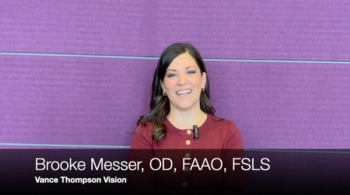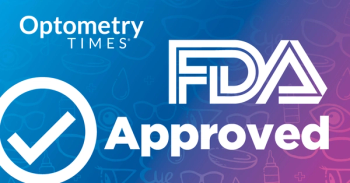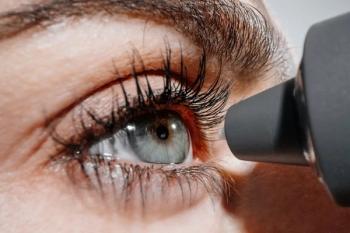
- Optometry Times August 2019
- Volume 11
- Issue 8
OD research at ARVO 2019
It is difficult to take it all in, let alone summarize the information gained by attending an Association of Research in Vision and Ophthalmology (ARVO) annual scientific meeting.
In my opinion, every optometrist should attend at least one ARVO meeting in their professional careers, and the earlier the better. This year’s meeting in Vancouver saw a record-setting 11,000 attendees from more than 75 countries. Some of the presentations that ODs are involved with are literally out of this world.
Read last year's recap:
A brief review of topic themes of papers, posters, and presentations is listed below.
Spaceflight-associated neuro-ocular syndrome
Spaceflight-associated neuro-ocular syndrome (SANS) syndrome affects about 40 percent of astronauts on long-duration spaceflights as assessed by one or more findings:
• Optic disc edema
• Hyperopic shifts
• Globe flattening
• Cotton-wool spots
• Choroidal folds
Researchers from Kentucky Colleges of Optometry and Osteopathic Medicine have an explanation of why astronauts develop pathologies more often in their right eyes after returning from long-duration spaceflights.
The researchers propose that a contributing factor is greater intraocular pressure (IOP) in the right eye versus the left eye when astronauts are in a nonstandard (head down) body position, as would be expected in an environment with low gravity.
IOP increased OD relative to OS during head down tilt with a 19 percent increase at a 45° head tilt, while no differences were seen in the supine position.
The researchers attribute this to anatomic variations in internal jugular vein distension and drainage, contributing to both the increased IOP and optic disc edema.2Related:
Detect TBI using virtual reality
Back on earth, traumatic brain injury (TBI) is a real and present danger for motorists and pedestrians as well as civilians of all ages engaged in sports and soldiers.
Patients with TBI, even mild TBI, often show impaired stereopsis not appreciated during a conventional eye exam. Measuring stereopsis in different positions of the visual field with virtual reality glasses seems to be an effective new tool for fast concussion assessment.
Looking through computer-tethered virtual reality glasses, German scientists displayed four balls with differing stereo offset presented in nine different positions of the visual field. The task was to evaluate third-degree fusion (stereopsis) in all gaze positions by selecting the closer ball using a gaming controller.3Related:
This technology is being used to train athletes. Ocular healthy athletes improved their stereo vision over a six-week time frame in respect to disparity threshold, reaction time, gain, and percentage of correct answers.4
Consumer 3-D head-mounted displays provide potential for improving visual functions such as contrast sensitivity, visual crowding, and visual attention.
Scientists at UC Berkeley School of Optometry and Baylor College of Medicine Department of Neuroscience further explored the potential of 3-D video games to improve stereopsis. Playing stereoscopic 3-D video games for short periods of time improves depth perception by 33.5 percent in healthy young adults.
Notably, their most recent experiments have shown these types of video games to have a special benefit for triggering the plasticity of stereo vision in patients with amblyopia.5Related:
Distinguishing Alzheimer’s from other dementia with OCT
While dichoptic tests such as stereopsis are being extended to those patients suspected of having a neurodegenerative disorder such as Alzheimer’s or Parkinson’s disease, there was much interest at ARVO 2019 in the potential of spectral-domain OCT (SDOCT) to be used for the objective diagnosis of neurodegenerative diseases.
Alzheimer’s disease (AD) is difficult to clinically distinguish from frontotemporal degeneration (FTD), an age-related dementia with distinct brain pathology.
Researchers from the University of Pennsylvania Scheie Eye Institute and the Department of Neurology evaluated SDOCTs of these two district neurodegenerations (n=15 AD and n=33 FTD patients). Differences in retinal nerve fiber layer (RNFL) and ganglion cell layer (GCL) thicknesses were not seen.
However, outer retina thinning detected by SDOCT may distinguish FTD from AD. The researchers suggest that the thicker outer plexiform layer in FTD patients stems from bipolar and horizontal cell dendrite sprouting as the outer nuclear layer thins.6Related:
Tear test for Alzheimer’s disease
Tear biomarkers have been identified for several ocular diseases as well as neurological diseases like migraine, Parkinson’s disease, and multiple sclerosis.
Now a group from the University Eye Clinic and Departments of Psychiatry & Neuropsychology at Maastricht University Medical Center, Netherlands, has evaluated the tear biomarker level of total-tau and amyloid-beta 42 (Aβ42) in a cohort of n=25 patients with AD, mild cognitive impairment, or subjective cognitive impairment and n=9 age-matching healthy controls.
Although the sample size is small, their results suggest tear total-tau and Aβ42 have reasonable discriminatory power for the AD state with is potential for utility as a clinical diagnostic marker.7Related:
Driving and fall risk
At ARVO 2019, several presentations focused on driving and fall risk. These two topics are of clinical importance to optometrists adapting to examining an increasingly aged population.
Driving is a complex task involving cognitive, motor, and vision measures such as novel tests of central motion sensitivity and contrast sensitivity (CSF) that are significantly associated with driving performance among older adults with and without visual impairment.
However, standard worldwide vision licensing tests are not strongly predictive of driving performance.
Australian researchers, including Joanne M. Wood, BSc, PhD, from the Queensland School of Optometry, are moving toward identifying unsafe older drivers using a comprehensive performance model, which is important in those with visual impairment.8Related:
Is there a biomarker for predicting night vision difficulties during an eye examination? Our group at the James A. Lovell Federal Health Care Center found self-assessed global low luminance performance correlates with macular pigment optical density even in patients without retinal disease.9
Researchers from Australia once again have given much thought to another concern of elderly beyond driving: fear of falling. This concern potentially contributes to activity restriction, physical deconditioning, psychological distress, and reduced quality of life. Not surprisingly, higher levels of anxiety about falling are commonly found among older patients with age-related macular degeneration (AMD) and associated with their central vision loss.
Yearly declines in CSF were linked to increased levels of their concern about falling. The researchers’ findings highlight the need for monitoring “fall risk concern” among older people with AMD, particularly those with progressive vision loss. Regular assessment of CSF could assist in identifying those at greatest risk of fall risk concern.10Related:
Validation of a self-administered CSF test
Another poster confirmed the utility of a new simple home (or office) CSF test known as the CamBlobs2.
Researchers from the School of Optometry at Université de Montréal demonstrated that CSF measured with the CamBlobs2 chart agrees with the validated Mars chart in a group of multiple sclerosis patients with optic neuritis. Camblobs2 can be self-administered by patients at home as a self-monitoring tool.11
Related:
Fluorescence lifetime imaging ophthalmoscopy
The retina contains components (fluorophores) which glow back after illumination with light. Researchers from Bern, Switzerland, as well as at the University of Utah/Moran Eye Center presented several posters on this new imaging modality.
Fluorescence lifetime imaging ophthalmoscopy (FLIO) images show how long these fluorophores glow (fluorescence lifetimes), providing vital information about the metabolism and health of the retina.
The Bern group analyzed 141 healthy eyes of subjects with a broad age range (21 to 91 years) to construct a normative data base. The Moran Eye Center group is likewise evaluating patients with various disease states. Longer fluorescence lifetimes measured in older subjects indicate a change in composition of the retina over time. As with autofluorescence imaging, human lens status must be considered when analyzing FLIO.12Related:
Artificial intelligence
There were no less than 23 special topic presentations concerning artificial intelligence (AI), both novel applications and refinements (such as diabetic retinopathy). Some of the myriad and growing potential applications are nothing short of breathtaking.
See the specific AI topics:
• LASIK and PRK13
• Collaborative management of cataracts14
• Predicting chronic kidney disease (CKD) from retinal images15
• Visual screening with smartphones16
• Enhancing clinical trials17
• Glaucoma diagnosis18
• Distinguishing cavernous hemangioma and neurilemmoma19
• Infectious keratitis with slit-lamp images20
• Diabetic retinopathy using SDOCT and SDOCTA21
• Automatic detection of diabetic retinopathy22
• Predicting myopic macular degeneration23
• Classification of subclinical keratoconus using Scheimpflug and SDOCT24
• Immune related factors of intraocular disease25
• Fully automated feature-based segmentation of diabetic retinopathy26
• SDOCT and novel deep learning algorithms in Singapore27
• Glaucoma monitoring28
• Opacity suppression in teleretinal imaging29
• Optical Coherence Tomography and Artificial Intelligence for Glaucomatous Optic Neuropathy (OCTAGON) research group30
• Real-world use in diabetes clinics31
• Robotics and teleretinal medicine32
• Stargardt’s disease33
• Retinitis of prematurity34
• Subjective refraction from wavefront aberrometry35
References:
1. Macias B, Laurie S , Lee S, Martin D, Sargsyan A, Marshall-Goebel K, Ebert D, Dulchavsky S, Hargens A, Stenger MB. Elevated intracranial pressure does not explain spaceflight-induced optic disc edema. Invest Ophthalmol Vis Sci. 2019;60(9):4809.
2. Murthy N, Mutter MW, Bradley J, Watson LJ, Hickenbotham A, Kinzer E. Contribution of intraocular pressure disparity in head-down tilt to the development of Spaceflight-Associated Neuro-ocular Syndrome. Invest Ophthalmol Vis Sci. 2019;60(9):2260.
3. Kara DD, Ring M, Mehringer W, Eskofier B, Hennig FF, Michelson G. Detection of mild traumatic brain injury by a virtual reality system. Invest Ophthalmol Vis Sci. 2019;60(9):2304.
4. Michelson G, Kutzner B, Mehringer W, Paulus J, Ring M, Eskofier B. Dichoptic binocular vision training improved stereo vision in top athletes. Invest Ophthalmol Vis Sci. 2019;60(9):1798.
5. Bui J, Li B, Li B, Fung E, Antonucci M, Tran KD, Patel S, Chung STL, Levi DM, Li R. Stereoscopic 3D video games boost depth perception. Invest Ophthalmol Vis Sci. 2019;60(9):1797.
6. Kim BJ, Grossman M, Saludades A, Song D, Dunaief JL McGeehan B, Ying GS, Aleman TS, Irwin D. Optic retina thinning distinguishes fronto-temporal degeneration from Alzheimer’s disease. Invest Ophthalmol Vis Sci. 2019;60(9):2296.
7. Giljs M, Nuijts, RM, Ramakers I, Verhey F, Webers CAB. Differences in tear protein biomarkers between patients with Alzheimer’s disease and controls. Invest Ophthalmol Vis Sci. 2019;60(9):1744.
8. Wood JM, Black AA, Mallon J, Anstey K. Predictors of driving performance in older adults with and without visual impairment. Invest Ophthalmol Vis Sci. 2019;60(9):4259.
9. Richer S, Davis R, Novil S, Devishi A, Nassiri S, Davey PG. Predicting night vision difficulties during an eye examination. (Night Vision & Carotenoids RCT; Hines VA IRB 1052607-1, Baseline Data). Invest Ophthalmol Vis Sci. 2019;60(9):1828.
10. White U, Black AA, Wood JM, Delbaere K. Progressive central vision impairment and concern about falling: a longitudinal study. Invest Ophthalmol Vis Sci. 2019;60(9):4262.
11. Bachir V, Marinier JA, Wittich W, Tchakmakian L. Ganglion cell layer thickness on optical coherence tomography allows differentiation of MS patients without optic neuritis from age-matched controls. Invest Ophthalmol Vis Sci. 2019;60(9):2289.
12. Dysli C, Dysli M, Wolf S, Zinkernagel MS. Influence of age and lens status on fluorescence lifetimes in FLIO. Invest Ophthalmol Vis Sci. 2019;60(9):1579.
13. Debellemanière G, Crahay FX, Rampat R, Saad A, Gatinel D. A new nomogram for the Wavelight Refractive Suite based on Artificial Intelligence. Invest Ophthalmol Vis Sci. 2019;60(9):6431.
14. Wu X, Chen L, Liu Z, Lai W, Zhang K, Lin D, Chen K, Yu T, Wu D, Li C, Chen C, Zhu Y, Lin H. A universal artificial intelligence platform for collaborative management of cataracts. Invest Ophthalmol Vis Sci. 2019;60(9):1477. Tien Y Wong, Dejiang Xu, Daniel Ting, Simon Nusinovici, Carol Cheung, 15. Wong TY, Xu D, Ting D, Nusinovici S, Cheung C, Shyong TE, Cheng CY, Lee ML, Hsu W, Sabanayagam C. Artificial intelligence deep learning system for predicting chronic kidney disease from retinal images. Invest Ophthalmol Vis Sci. 2019;60(9):1468.
16. Solanki K. Artificial Intelligence Eye Screening Using Smartphones: The Good, the Bad and the Ugly. Paper presented at: Association for Research in Vision and Ophthalmology; Vancouver, April 28-May 2, 2019.
17. Schmidt-Erfurth U. Artificial Intelligence approaches to enrich clinical trials populations. Invest Ophthalmol Vis Sci. 2019;60(9):993.
18. C De Moraes CG. Artificial intelligence for glaucoma diagnosis. Invest Ophthalmol Vis Sci. 2019;60(9):1407.
19. Bi S, Lin H, Zhang K, Yang H. Artificial intelligence: A framework that can distinguish cavernous hemangioma and neurilemmoma automatically. Invest Ophthalmol Vis Sci. 2019;60(9):1471.
20. Vupparaboina KK, Vedula SN, Aithu S, Bashar SB, Challa K, Loomba A, Taneja M, Channapayya S, Richhariya A. Artificial intelligence based detection of infectious keratitis using slit-lamp images. Invest Ophthalmol Vis Sci. 2019;60(9):4236.
21. Govindasamy N, Ratra D, Dalan D, Mochi TB, Roy AS. Artificial intelligence effectively combined OCT and OCTA indices to improve early detection of diabetic retinopathy (DR). Invest Ophthalmol Vis Sci. 2019;60(9):1434.
22. Ceruso S, Bonaque-González S, Pareja-RÃos A, Rodriguez-Ramos JM, Marichal-Hernández JG, Carmona-Ballester D, Oliva R. Artificial intelligence for the automatic detection of diabetic retinopathy with feedback from key areas. Invest Ophthalmol Vis Sci. 2019;60(9):1435.
23. Tan TE, Ting DSW, Liu Y, Li S, Chen C, Nguyen Q, Wong CW, Hoang QV, Lee SY, Wong EYM, Yeo IYS, Wong YL, Cheng CY, Saw SM, Cheung GCM, Wong TY. Artificial intelligence using a deep learning system with transfer learning to predict refractive error and myopic macular degeneration from color fundus photographs. Invest Ophthalmol Vis Sci. 2019;60(9):1478.
24. Shen M, Shi C, Chen S, Jiang J, Ye Y, Lu F. Classification of subclinical keratoconus based on the combination of Scheimpflug and Spectral-Domain OCT imaging data using artificial intelligence. Invest Ophthalmol Vis Sci. 2019;60(9):1481.
25. Nezu N, Usui Y, Asakage M, Shimizu H, Ogawa M, Yamakawa N, Yanagida C, Tsubota K, Narimatsu A, Maruyama K, Saito A, Kuroda M, Goto H. Determining immune-related factors of intraocular diseases by artificial intelligence methods. Invest Ophthalmol Vis Sci. 2019;60(9):5369.
26. Wu Y, Wang F, Xiao S, Kihara Y, Spaide T, Lee CS, Lee AY. Fully automated artificial intelligence (AI) pipeline for feature-based segmentation and classification of diabetic retinopathy in fundus photographs. Invest Ophthalmol Vis Sci. 2019;60(9):2205.
27. Girard MJA, Cheong H, Devalla SK, Subramanian G, Tan Hung Pham TH, Tin A Tun TA, Perera S, Aung A, Schmetterer L, Thiery A. Getting more with less: Artificial intelligence can boost optical coherence tomography images. Invest Ophthalmol Vis Sci. 2019;60(9):1505.
28. Yousefi S, Elze T, Pasquale L, Boland MV. Glaucoma monitoring using an artificial intelligence enabled map. Invest Ophthalmol Vis Sci. 2019;60(9):2439.
29. Chandrasekaran S, Kommana S, Szirth B, Albert S Khouri AS. Non-enhanced vs software enhanced images of the optic nerve head and nerve fiber layer in tele-glaucoma screening. Invest Ophthalmol Vis Sci. 2019;60(9):5521.
30. Thiery A. OCTAGON: Optical Coherence Tomography & Artificial Intelligence for Glaucomatous Optic Neuropathy. Invest Ophthalmol Vis Sci. 2019;60(9):1406.
31. Barriga ES, Benson J, Zamora G, Lozano J, Nemeth SC, Soliz P. Real-world use of artificial intelligence to screen for diabetic retinopathy at diabetes care clinics. Invest Ophthalmol Vis Sci. 2019;60(9):5462.
32. Ooms A, Caterfino A, Prasad N, Khouri P, Wilson L, Szirth B. Robotics and artificial intelligence in the management of vision threatening disease. Invest Ophthalmol Vis Sci. 2019;60(9):1486.
33. Al-Kadhi SY, Skouti L, Ellis A, Zeng Q, Sharma T, Tsang SH, Tezel TG. The use of artificial intelligence for the detection of Stargardt’s disease from fundus images. Invest Ophthalmol Vis Sci. 2019;60(9):1501.
34. Gómez AA, Franco RG, Neria PR, MarÃn DM, Lansingh VC, Star EL, Lorenzo XM, Morales VR, Roa MG, Gómez YV, Membrillo MV. Telemedicine screening for retinopathy of prematurity (ROP) using digital retinal images: A pilot study. Invest Ophthalmol Vis Sci. 2019;60(9):6532.
35. Carracedo G, Torres GC, Serramito M, Aroco AP, Lafora MR, Vidal TE, Valderas LB. Efficacy of aberrometry-based binocular refraction compared with subjective refraction in keratoconus patients. Invest Ophthalmol Vis Sci. 2019;60(9):4841.
Articles in this issue
about 6 years ago
What happened over 10 yearsabout 6 years ago
The possible connection among kids, devices, and myopiaabout 6 years ago
How to guide patients in the use of digital devicesabout 6 years ago
Accident or child abuse?about 6 years ago
Controversies in pediatric refractive developmentabout 6 years ago
How to treat dry eye in the pediatric and young adult populationabout 6 years ago
Research initiatives offer treatment options for diabetes patientsabout 6 years ago
Is optometry ready for the age of smartphone imaging?about 6 years ago
Q&A: Barbecue, OD-MD communication, lifelong learningabout 6 years ago
How climate change affects allergiesNewsletter
Want more insights like this? Subscribe to Optometry Times and get clinical pearls and practice tips delivered straight to your inbox.



















































.png)


